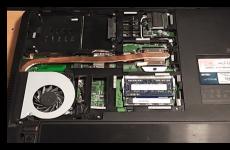Which is better LCD or plasma? Plasma monitor Which TV is better than plasma LCD
Today you can still hear the question of which is better, plasma or LCD TV. Many users who do not understand electronics well apply the term "plasma" to all modern TVs with a large screen size and high cost. The roots of this attitude lie in the 2000s, when large-diagonal TV equipment was either projection (TVs were a huge three-dimensional device with a built-in projector) or plasmas with a marsh-colored screen. At that time, buying a plasma was a big deal, especially from the Pioneer brand, which was considered the best of the best in this field. However, today, in 2020, the situation is completely different.
The plasma matrix is a collection of miniature fluorescent lamps (gas cells) that glow when current passes through them. Each pixel of such a matrix is a capacitor with electrodes, consisting of three light bulbs with ionized gas. When a cell is activated electric charge, one of the lamps glows, emitting light in one of three primary colors (blue, green or red). The speed of changing the color and operating order of the lamps is at least 400 Hz, which is not noticeable to the human eye. As a result, the viewer sees a “picture” High Quality and brightness without noticing flickering. This frequency exceeds the speed of LCD matrices, where black pixels are added to improve this parameter.
Plasma panel device
When visually examining a TV, you can determine its type (plasma or liquid crystal) by the color of the screen when it is turned off. Plasma has a greenish (swamp) color. During operation, it can be recognized by temperature: such a TV is in operation gets very hot.
This type of equipment is purchased by “film gourmets”, for whom the frame rate, color rendering quality and depth of black color are important.
The problem with plasma TVs is a fixed picture for a long time. In the plasma matrix, such a place “burns out”, remaining forever a translucent shadow. Often this situation occurs when a DVD player freezes: when it is paused, or the user did not turn it off after watching a movie, and the abbreviation “DVD” glowed on the screen all night. This also happens when used carefully, for example, if there is a favorite television channel, its icon will also remain a shadow.

One of the problems with plasma is screen burnout under a static picture.
Such significant shortcomings, coupled with high energy consumption made plasmas unpopular, and subsequently completely unclaimed. The LEDs and LED matrices that replaced them turned out to be much better: with similar picture quality, they themselves cost less and consume electricity more economically.
Important! Since 2014, plasmas have not been produced or supplied in Russia.
Types of LCD Panels
The modern market offers three leading technologies. Each differs in both operating principle and cost. The latest developments are the most “advanced”, budget models the simplest ones, they are obsolete, but to this day they are in great demand due to their affordability and practicality.
For a complete understanding, it should be clarified that only those models of LCD TVs that are currently sold will be analyzed. They are significantly superior to samples from earlier years of production.

Like any new product, an OLED panel is more expensive than previous types, and the difference can reach 10 times the size. This is compensated by an excellent image, as well as an impressive diagonal of more than 55 inches.
Advantages of LCD TVs
Liquid crystal display (LED) TVs have taken the world by storm. For 2020, this is the most popular television technology. This is understandable, with so many advantages.
High picture contrast
The technology used here provides a number of advantages. The image turns out to be contrasty, even in those areas where the “source” contains low-contrast images. Bright LED backlight makes the image as close to natural as possible, with a natural variety of colors. The second advantage of this solution is that the screen brightness during operation is independent of ambient lighting. 
Image clarity
LCD TVs show a picture that is as close as possible to the real one due to high detail. The viewing angle of such TVs is not fundamentally different from that of plasma TVs. It is enough even for almost side-to-side viewing from the screen.
Economical
Given the constant rise in energy prices, energy efficiency of equipment is becoming one of the key issues when choosing. An LED TV using LED backlighting is 40% more economical than the old version of LCD TVs. Edge-lit panels (EDGE) are even more energy efficient.
Environmental friendliness
LED TVs are made with care for nature: in crystals no mercury. This circumstance gives the right to certification according to all modern environmental safety standards.
Compact size
A modern TV is an elegant interior detail. Its thickness can be only 2.5 cm, and the screen takes up 100% of the area. Designers of manufacturing companies are working to ensure that the TV is not just a device, but becomes a real decoration of the interior.

Modern TVs perfectly complement the interior
Large selection of additional options
The latest generation LED TV is multifunction device, combining the capabilities of a TV, video player from different media, and a multiport communicator. The TV has a built-in board that helps you work with different data formats, go out in world wide web and work fully in it.
Summarizing
Thus, today it is already difficult to say which is better - a plasma or LCD TV, since the market simply did not leave us a choice. Plasma panels are a thing of the past. Modern LED TVs are superior to them in most respects. However, it is unknown how long their triumph will last. New technologies, for example, QLED screens, promise even greater benefits: unsurpassed brightness, saturation, color gamut. However, in 2020, the dominance of LED is an undeniable fact.
Plasma TVs have earned great popularity among users over the years of their development. It was the image quality that enabled plasma devices to occupy leading positions in the television screen market until the introduction of ultra-high resolution Ultra HD in 2014. This article was written in 2014 and the information is current at that time. In 2015, there were no longer plasma TVs from world brands on sale. The situation is the same in 2016, plasma left the TV screen market.
How does a plasma screen work?
Modern flat panel displays are made up of individual dots. If a TV's resolution is measured in pixels, then each pixel is made up of three individual dots (subpixels). Each dot is colored in its own color: red, green, blue. In color television, it is from these three primary colors that all the others are obtained by mixing. In plasma screens, the resolution can be Full HD (1920x1080 pixels) or HD Ready (1366x768 pixels), and in each case there are three times more dots.
Flat panel TV screens are divided into two types: those in which each point itself emits light and those in which the screen elements transmit the required amount of light from the light source. Screens with elements that transmit light are called liquid crystal screens. It is the cells with liquid crystals that transmit the amount of light through themselves, depending on the position of the crystal in the cell. In this case, the light sources can be either a lamp, then the TV is called LCD, or LEDs, then the TV is called LED. Today, backlight lamps are no longer used, only LEDs remain, therefore both “LCD” and “LED” designate one type of TV: on a liquid crystal matrix with backlighting from LEDs.
Screens, in which each point itself is a light source, have a completely different manufacturing technology and a different principle of image formation. These screens include plasma and OLED.
Today, OLED screens are built on light-emitting diodes and very few OLED TV models are commercially available. These are the flagship models of each manufacturer and they are expensive.
Plasma panels consist of cells that have gas inside and when voltage is applied, a discharge is created in the gas (plasma). And it is from this that ultraviolet radiation emanates, which then affects the phosphor, the glow of which we see.
Operating principle of the display cell
The processor selects the desired pixel and supplies the cells with a voltage that depends on the transmitted image at that point. And so all the pixels are updated one by one. In modern plasma TVs, the entire screen can be updated 400-600 times in one second; in the specifications this is indicated as a frame frequency of 400 Hz or 600 Hz. At this frequency, a person will not be able to see flickering on the screen, and the display of video in dynamic scenes also improves. And compared to LCD TVs, the response time of the cell to the control signal is better for plasma, which gives an advantage in such a parameter as response time.
Additional functions of TVs, such as 3D, Smart TV, the ability to connect other devices, etc., do not depend on the screen technology and they are just as present on plasma TVs as on others. You just need to look at the characteristics of each model so that the set contains what you need.
Advantages of plasma screens
Over the years, plasma and LCD displays have seen many comparisons between the two technologies. All these comparisons only speak about the advantage of plasma panels in image quality over LCD.
BLACK LEVEL AND CONTRAST
One of the main indicators of screen quality is the black level in the image that the screen can provide. And in this indicator, screens with technology in which the cell itself emits light always win. And this includes plasma and OLED and picture tubes that have already left the market.
In liquid crystal matrices, the cell with the crystal cannot completely block the light from the LEDs and therefore the black areas of the image have a shade of gray. To correct this problem, the LEDs in the backlight change their brightness in groups, and thus increase the black level in areas of the screen where a dark scene in the image is currently displayed. This is called dynamic contrast because it changes depending on the brightness of the backlight. But the static contrast of the matrix remains unchanged and is worse for LCDs. But plasma does not have such problems, and to display black, voltage is simply not applied to the cells and they do not glow. This produces natural black. This means that the contrast of the plasma will be higher. Contrast is the ratio of the brightness of the lightest area in an image to the brightness of the darkest area.
COLOR RENDERING
Due to good contrast, color rendition is better and the color gamut is greater than that of LCD screens.
As for OLED displays, their image parameters are better than both plasma and LCD, so both older technologies lose comparison with them.
 Plasma TV SAMSUNG PS51F8500
Plasma TV SAMSUNG PS51F8500 Flaws
Years of development of plasma screens have made it possible to overcome the disadvantages inherent in this technology at the beginning of its development.
Yes, plasma brightness is less than that of LCD TVs, especially with LED backlight and in a brightly lit room this can be a problem. But when watching at home plasma TVs show sufficient screen brightness.
LIFE TIME
Fragility also faded into the background. Modern plasma TVs have an operating time of several tens of thousands of hours, and this may be less than other technologies, but this is quite enough for many years of service.
SCREEN BURN IN
This problem was inherent in the first models of plasma screens, especially when there was a motionless picture on the screen for a long time. This could be the channel's logo if you watched it all the time. Modern models of plasma TVs have successfully overcome this drawback.
Development of plasma TVs for 2014
We can say that the peak of popularity of plasma TVs has already passed. Pioneer has long ceased production of its plasma TVs (since 2010), its models of the Kuro family were especially famous. Nobody could compete with these TVs at that time.
After Pioneer left, Panasonic took over the leadership in the production of plasma TVs. In 2013, one of the best models plasma TV of all time called Panasonic TX-P60ZT60, the ZT60 series is considered the best among plasma TVs, and the VT60 series is also recognized as one of the best. And in March 2014, Panasonic stopped producing plasma TVs.
 Plasma TV Panasonic TX-P60ZT60
Plasma TV Panasonic TX-P60ZT60 After Panasonic left the plasma TV market, large manufacturers Samsung and LG also produced plasma panels. But already in the 2014 lineup of models with plasma screens there were very few, and they were more in budget segment. Flagship models are manufactured with LED and OLED screens.
And so in the fall of 2014, LG and Samsung stopped producing plasma TVs. Today, little-known companies are still producing models of plasma television receivers. But these devices do not occupy a leading position in the television receiver market.
The main focus today by all television equipment manufacturers is on the development of ultra-high resolution 4K Ultra HD and OLED screens. It is precisely the inability to support ultra-high resolution, which is 4 times higher than Full HD, that did not allow the further development of plasma screen manufacturing technology. And the main group of models for different price ranges is occupied by representatives of LED TVs.
Plasma Samsung TVs for 2014: PE H4500, PE H4000. There are different diagonals, as well as in the lineup Representatives from 2013 also entered. Experts note the 2013 model PS F8500.
LG Plasma TVs for 2014: RV6600, RV5600.
Super User details About TVs
The technologies for producing plasma, LCD (CCFL LCD) and LED (LED LCD) TVs are well developed today, so they all produce a fairly high-quality picture. And yet, what is better: plasma or LCD? Both plasma panels and their brothers LCD and LED TVs have their pros and cons.
Why brothers? Because they are produced using the same technology and differ only in the lighting method.
Plasma panelsThey give a fairly high-quality picture: true black color and generally realistic color rendition, high contrast, wide viewing angles and short response time.
Disadvantages: the brightness is not high enough and watching TV in a sunny room will not be so comfortable, high energy consumption, large dimensions.
"Screen burnout" is the process of phosphorus burning in the cell. As a result, a frequently displayed image, such as a logo, may be remembered on the screen. This problem exists with plasma, but even the first models had a service life of 30,000 hours (about 10 years). And today manufacturers claim the service life of panels is comparable to LCD TVs.
Another disadvantage is that it is impossible to create plasma with a diagonal size smaller than 32 inches. But the price of a large diagonal plasma is lower than that of the same diagonal LCD or LED.
U LCD (CCFL LCD) TVs Brightness is better than plasma, power consumption is lower. Response time and viewing angles are inferior to plasma, but they are sufficient for comfortable viewing. Color rendering and contrast are at the same level, and differ from manufacturer to manufacturer. Although it should be noted that the black color is not truly black, but rather dark gray. This is due to the features of the technology.
LED (LED LCD) TVs, Also being LCD TVs, they are thinner than CCFL LCD due to the fact that LEDs are used instead of fluorescent lamps to backlight the liquid crystal panel. This improves color rendering. The downside is the price. According to this indicator, they are inferior to LCD (CCFL LCD) TVs and plasma. Besidesthese TVs have nSome illumination unevenness. These are the features of LCD technology. But today this is the most modern technology mass production of televisions.
Knowing the pros and cons of all technologies, you can decide whether a plasma or LCD TV is better for you.
P.S. The first CCFL LCD TVs have already left the TV market. Plasma production ceased in 2014. LED LCD still occupies the main TV market. But it's already being replaced new technology - OLED. Stated prices for Oled TVs still very high. But they are already on sale. About models that are entering the market
Every year, plasma panels are becoming more and more popular among buyers, which has largely contributed to their reduction in price. According to experts, in the very near future they will completely replace both obsolete CRT televisions and LCD models.
Plasma TV is a solution for everyone!
Some ordinary people believe that there is no difference between plasma and LCD, and they differ only in screen diagonal. In fact, this is far from the case. Plasma models are produced using a completely different technology that has nothing in common with LCD screens. It is based on the use of a unique plasma matrix that produces high-definition images.
One of the main advantages of plasma is its versatility. It will satisfy not only owners, but also gamers. “Plasma” is always very popular with children who simply adore cartoons on big screen. Accordingly, such a TV is aimed at a fairly wide consumer audience, and not just at fans of spectacular cinema
To choose the right plasma TV, pay attention to the screen diagonal
Choosing a plasma TV is not a difficult task. However, when purchasing it, there are several things to take into account: important nuances. And first of all, the size of the TV screen. It is worth noting that plasma models with a small diagonal simply do not exist. This is due to the fact that the production of such TVs is not profitable. To choose the right plasma TV, remember that minimum size its screen is 32 inches. The maximum dimensions of modern panels can reach up to 72 inches or even more.
Such an important parameter as the screen format also depends on the diagonal size of a plasma TV. Models with a 16:9 format are optimal for home viewing, which allows you to play video of excellent quality. Therefore, when buying “plasma”, look for a TV with this format.
If you want to choose the right plasma TV, ask about its resolution
Another key parameter of a plasma TV is its resolution. Not only the clarity of the “picture”, but also the brightness of the colors depends on it. Currently, HD resolution with 1080i or 1080p is considered almost ideal.
To choose the right plasma TV, pay attention to the number of input ports on its body. A modern “plasma” must have at least one HDMI port with support for the HDCP protocol. It is advisable that the TV provides the ability to connect to a computer - this will require VGA or DVI inputs. It goes without saying that any plasma TV should also have ports for a simple DVD player.
When choosing a TV, many of us have no idea what to look for. Some people are only interested in the display picture, so when visiting a store, they focus only on the visual impression. Others prefer to study the equipment specifications and user reviews before making a purchase. You can also get good advice from the seller. Let's try to understand the question of which TV is better: LCD or plasma? To do this, we need to compare their main indicators and characteristics.
Which TV is better: LCD or plasma?
The second has higher brightness and contrast. In addition, it gives very rich and rich colors and shades in wide range. It should be noted that the viewing angle is much wider for plasma. This is because the pixels used in this TV are capable of emitting light themselves. And LCD panels use a special lamp for these purposes. The light from it, passing through the pixel crystal, produces an image.

When determining which TV is better: LCD or plasma, you should also point out some of their shortcomings. Before making a purchase, decide what size TV panel you need. The fact is that plasma TVs with a diagonal smaller than 32 inches are not produced. Their manufacturing technology involves the use of fairly large pixels. Therefore, to achieve good extension Manufacturers are forced to increase the display size. The second drawback is the ability to view high-quality images only with long distance. Otherwise, the pupils may catch a subtle flicker, causing eye fatigue. The third drawback is phosphor burnout, which limits the service life of the display. Also noteworthy is the high energy consumption and high price.
Disadvantages of LCD TVs
Main flaws - low quality transmitted signals and poor broadcast of terrestrial television. These features should undoubtedly be taken into account when answering the question of which TV is better: LCD or plasma. However, when you connect a PC or other high-quality source, you can get a pretty good picture. In addition, manufacturers increasingly began to integrate card readers, tuners for cable networks, hard disks etc. This allows this TV receiver to remain in demand for a long time.

So, we choose TV. Which is better? Let's analyze another type of TV receiver, which has recently appeared on the market. household appliances. We are talking about an LED TV. We can say that this is a cross between LCD and plasma. It shows pretty well terrestrial television. Also, an LED TV has a better picture quality than an LCD and does not produce noise. Today there are a huge variety of TV panels of this type on the market.
Which LED TV is better?
Experts recommend purchasing a TV panel with a diagonal of 32-42 inches. In this case, the TV should be at least two meters away from the eyes. This position will allow you to achieve more comfortable and high-quality viewing. It is best to purchase an LED TV with a higher resolution. This indicator significantly affects the quality of the picture. High level Contrast and color quality are achieved through the presence of backlighting. However, the panel screen is noticeably thicker than when using side LEDs. Determine the important criteria for yourself and make the right choice.







